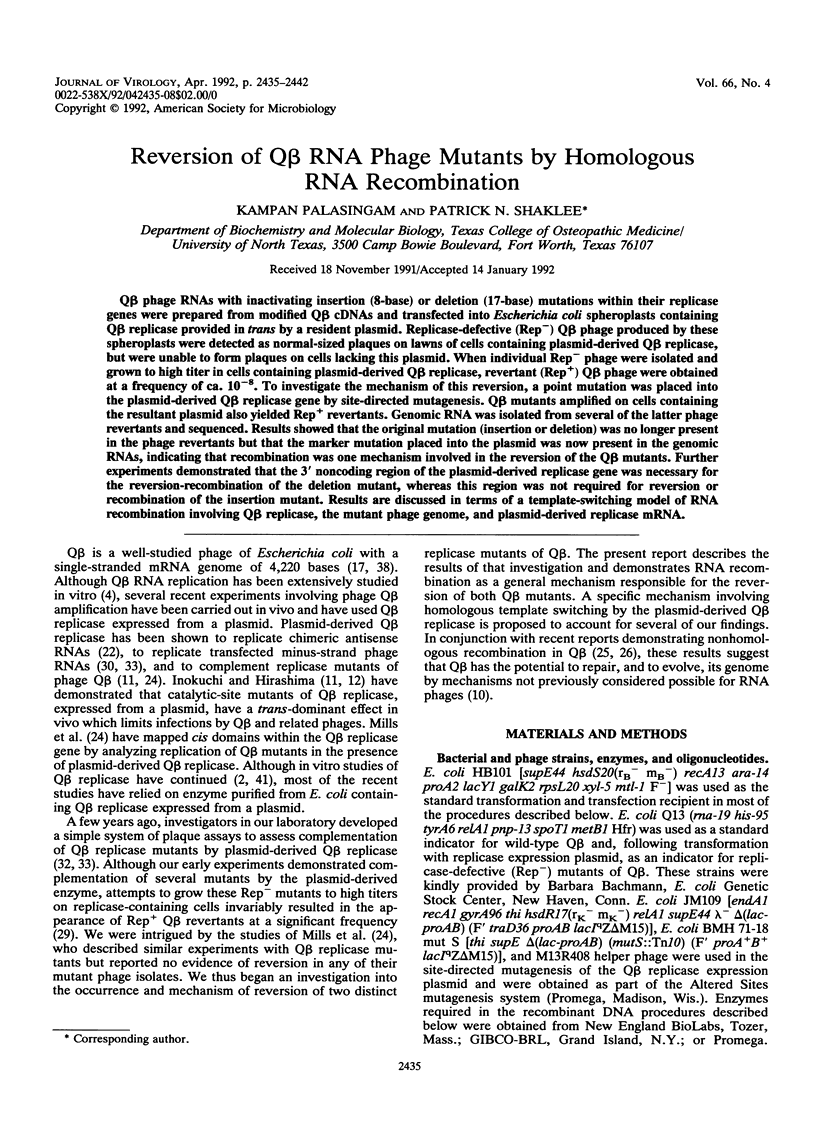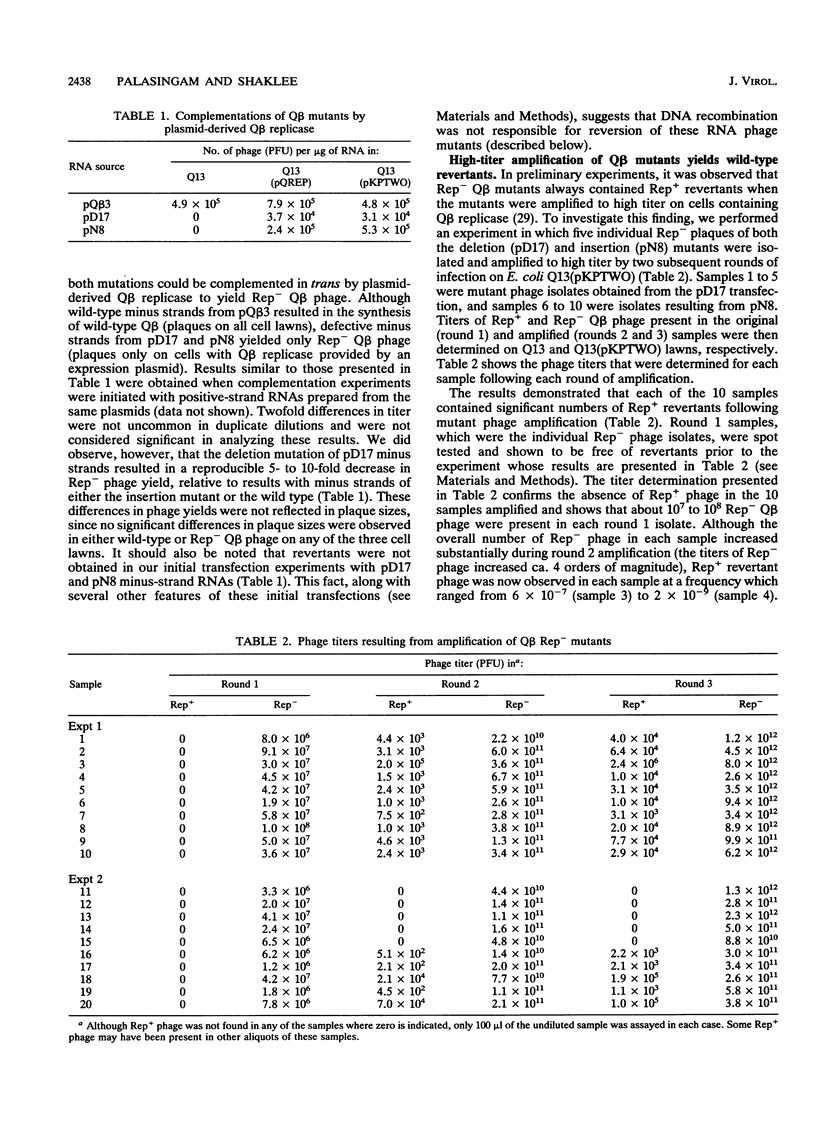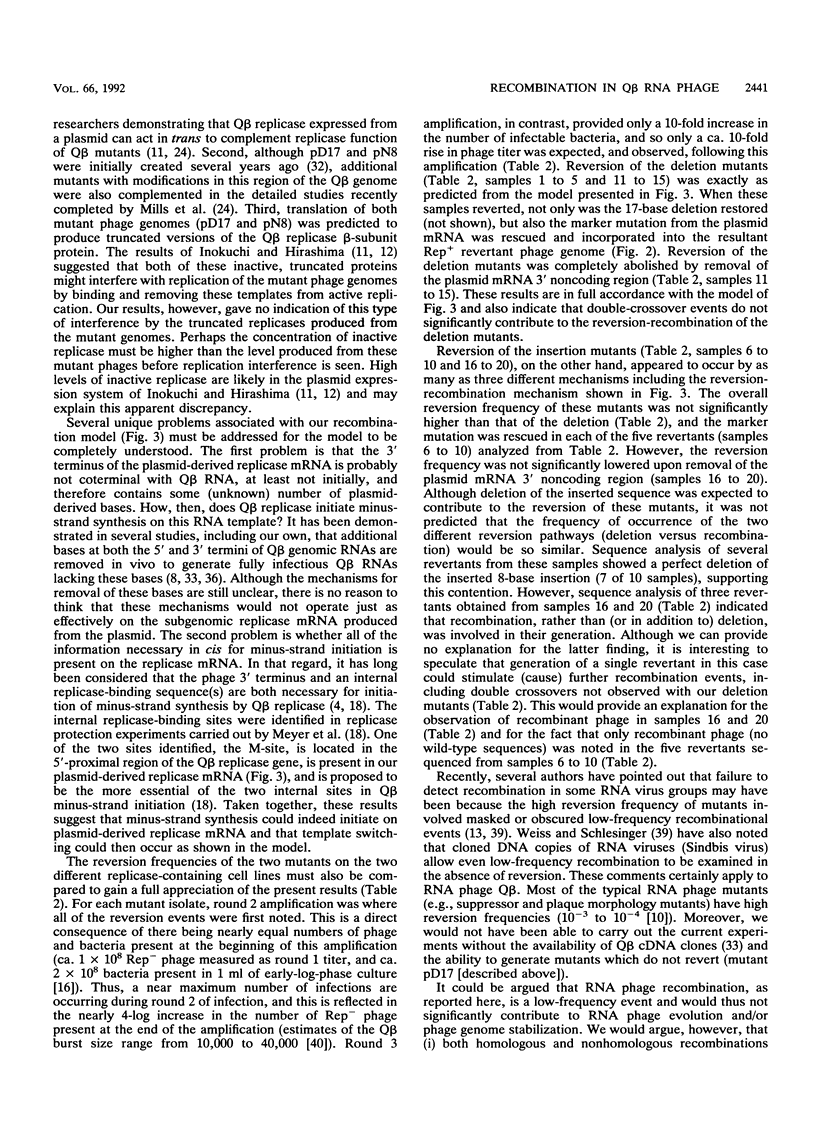Abstract
Q beta phage RNAs with inactivating insertion (8-base) or deletion (17-base) mutations within their replicase genes were prepared from modified Q beta cDNAs and transfected into Escherichia coli spheroplasts containing Q beta replicase provided in trans by a resident plasmid. Replicase-defective (Rep-) Q beta phage produced by these spheroplasts were detected as normal-sized plaques on lawns of cells containing plasmid-derived Q beta replicase, but were unable to form plaques on cells lacking this plasmid. When individual Rep- phage were isolated and grown to high titer in cells containing plasmid-derived Q beta replicase, revertant (Rep+) Q beta phage were obtained at a frequency of ca. 10(-8). To investigate the mechanism of this reversion, a point mutation was placed into the plasmid-derived Q beta replicase gene by site-directed mutagenesis. Q beta mutants amplified on cells containing the resultant plasmid also yielded Rep+ revertants. Genomic RNA was isolated from several of the latter phage revertants and sequenced. Results showed that the original mutation (insertion or deletion) was no longer present in the phage revertants but that the marker mutation placed into the plasmid was now present in the genomic RNAs, indicating that recombination was one mechanism involved in the reversion of the Q beta mutants. Further experiments demonstrated that the 3' noncoding region of the plasmid-derived replicase gene was necessary for the reversion-recombination of the deletion mutant, whereas this region was not required for reversion or recombination of the insertion mutant. Results are discussed in terms of a template-switching model of RNA recombination involving Q beta replicase, the mutant phage genome, and plasmid-derived replicase mRNA.
Full text
PDF







Images in this article
Selected References
These references are in PubMed. This may not be the complete list of references from this article.
- Allison R., Thompson C., Ahlquist P. Regeneration of a functional RNA virus genome by recombination between deletion mutants and requirement for cowpea chlorotic mottle virus 3a and coat genes for systemic infection. Proc Natl Acad Sci U S A. 1990 Mar;87(5):1820–1824. doi: 10.1073/pnas.87.5.1820. [DOI] [PMC free article] [PubMed] [Google Scholar]
- Axelrod V. D., Brown E., Priano C., Mills D. R. Coliphage Q beta RNA replication: RNA catalytic for single-strand release. Virology. 1991 Oct;184(2):595–608. doi: 10.1016/0042-6822(91)90430-j. [DOI] [PubMed] [Google Scholar]
- Banner L. R., Lai M. M. Random nature of coronavirus RNA recombination in the absence of selection pressure. Virology. 1991 Nov;185(1):441–445. doi: 10.1016/0042-6822(91)90795-D. [DOI] [PMC free article] [PubMed] [Google Scholar]
- Blumenthal T., Carmichael G. G. RNA replication: function and structure of Qbeta-replicase. Annu Rev Biochem. 1979;48:525–548. doi: 10.1146/annurev.bi.48.070179.002521. [DOI] [PubMed] [Google Scholar]
- Bujarski J. J., Dzianott A. M. Generation and analysis of nonhomologous RNA-RNA recombinants in brome mosaic virus: sequence complementarities at crossover sites. J Virol. 1991 Aug;65(8):4153–4159. doi: 10.1128/jvi.65.8.4153-4159.1991. [DOI] [PMC free article] [PubMed] [Google Scholar]
- Chen E. Y., Seeburg P. H. Supercoil sequencing: a fast and simple method for sequencing plasmid DNA. DNA. 1985 Apr;4(2):165–170. doi: 10.1089/dna.1985.4.165. [DOI] [PubMed] [Google Scholar]
- Gilvarg C., Bollum F. J., Weissmann C. The in vitro addition of a polyadenylate sequence to the 3' end of phage Qbeta RNA and the biological activity of the product. Proc Natl Acad Sci U S A. 1975 Feb;72(2):428–432. doi: 10.1073/pnas.72.2.428. [DOI] [PMC free article] [PubMed] [Google Scholar]
- Grimsley N., Hohn T., Hohn B. Recombination in a plant virus: template-switching in cauliflower mosaic virus. EMBO J. 1986 Apr;5(4):641–646. doi: 10.1002/j.1460-2075.1986.tb04261.x. [DOI] [PMC free article] [PubMed] [Google Scholar]
- Inokuchi Y., Hirashima A. Interference with viral infection by RNA replicase deleted at the carboxy-terminal region. J Biochem. 1990 Jul;108(1):53–58. doi: 10.1093/oxfordjournals.jbchem.a123162. [DOI] [PubMed] [Google Scholar]
- Inokuchi Y., Hirashima A. Interference with viral infection by defective RNA replicase. J Virol. 1987 Dec;61(12):3946–3949. doi: 10.1128/jvi.61.12.3946-3949.1987. [DOI] [PMC free article] [PubMed] [Google Scholar]
- Jarvis T. C., Kirkegaard K. The polymerase in its labyrinth: mechanisms and implications of RNA recombination. Trends Genet. 1991 Jun;7(6):186–191. doi: 10.1016/0168-9525(91)90434-R. [DOI] [PMC free article] [PubMed] [Google Scholar]
- Kirkegaard K., Baltimore D. The mechanism of RNA recombination in poliovirus. Cell. 1986 Nov 7;47(3):433–443. doi: 10.1016/0092-8674(86)90600-8. [DOI] [PMC free article] [PubMed] [Google Scholar]
- Meyer F., Weber H., Weissmann C. Interactions of Q beta replicase with Q beta RNA. J Mol Biol. 1981 Dec 15;153(3):631–660. doi: 10.1016/0022-2836(81)90411-3. [DOI] [PubMed] [Google Scholar]
- Miele E. A., Mills D. R., Kramer F. R. Autocatalytic replication of a recombinant RNA. J Mol Biol. 1983 Dec 15;171(3):281–295. doi: 10.1016/0022-2836(83)90094-3. [DOI] [PubMed] [Google Scholar]
- Mills D. R. Engineered recombinant messenger RNA can be replicated and expressed inside bacterial cells by an RNA bacteriophage replicase. J Mol Biol. 1988 Apr 5;200(3):489–500. doi: 10.1016/0022-2836(88)90538-4. [DOI] [PubMed] [Google Scholar]
- Mills D. R., Kramer F. R., Spiegelman S. Complete nucleotide sequence of a replicating RNA molecule. Science. 1973 Jun 1;180(4089):916–927. doi: 10.1126/science.180.4089.916. [DOI] [PubMed] [Google Scholar]
- Mills D. R., Priano C., Merz P. A., Binderow B. D. Q beta RNA bacteriophage: mapping cis-acting elements within an RNA genome. J Virol. 1990 Aug;64(8):3872–3881. doi: 10.1128/jvi.64.8.3872-3881.1990. [DOI] [PMC free article] [PubMed] [Google Scholar]
- Munishkin A. V., Voronin L. A., Chetverin A. B. An in vivo recombinant RNA capable of autocatalytic synthesis by Q beta replicase. Nature. 1988 Jun 2;333(6172):473–475. doi: 10.1038/333473a0. [DOI] [PubMed] [Google Scholar]
- Munishkin A. V., Voronin L. A., Ugarov V. I., Bondareva L. A., Chetverina H. V., Chetverin A. B. Efficient templates for Q beta replicase are formed by recombination from heterologous sequences. J Mol Biol. 1991 Sep 20;221(2):463–472. doi: 10.1016/0022-2836(91)80067-5. [DOI] [PubMed] [Google Scholar]
- Queen C. A vector that uses phage signals for efficient synthesis of proteins in Escherichia coli. J Mol Appl Genet. 1983;2(1):1–10. [PubMed] [Google Scholar]
- Schaffner W., Rüegg K. J., Weissmann C. Nanovariant RNAs: nucleotide sequence and interaction with bacteriophage Qbeta replicase. J Mol Biol. 1977 Dec 25;117(4):877–907. doi: 10.1016/s0022-2836(77)80004-1. [DOI] [PubMed] [Google Scholar]
- Shaklee P. N., Miglietta J. J., Palmenberg A. C., Kaesberg P. Infectious positive- and negative-strand transcript RNAs from bacteriophage Q beta cDNA clones. Virology. 1988 Mar;163(1):209–213. doi: 10.1016/0042-6822(88)90250-4. [DOI] [PubMed] [Google Scholar]
- Shaklee P. N. Negative-strand RNA replication by Q beta and MS2 positive-strand RNA phage replicases. Virology. 1990 Sep;178(1):340–343. doi: 10.1016/0042-6822(90)90417-p. [DOI] [PubMed] [Google Scholar]
- Shaklee P. N. Similar conformers in the minus strands of divergent positive strand RNA phage. Virology. 1991 Dec;185(2):872–874. doi: 10.1016/0042-6822(91)90562-p. [DOI] [PubMed] [Google Scholar]
- Sherry B., Mosser A. G., Colonno R. J., Rueckert R. R. Use of monoclonal antibodies to identify four neutralization immunogens on a common cold picornavirus, human rhinovirus 14. J Virol. 1986 Jan;57(1):246–257. doi: 10.1128/jvi.57.1.246-257.1986. [DOI] [PMC free article] [PubMed] [Google Scholar]
- Strauss J. H., Jr, Sinsheimer R. L. Characterization of an infectivity assay for the ribonucleic acid of bacteriophage MS2. J Virol. 1967 Aug;1(4):711–716. doi: 10.1128/jvi.1.4.711-716.1967. [DOI] [PMC free article] [PubMed] [Google Scholar]
- Taniguchi T., Palmieri M., Weissmann C. QB DNA-containing hybrid plasmids giving rise to QB phage formation in the bacterial host. Nature. 1978 Jul 20;274(5668):223–228. doi: 10.1038/274223a0. [DOI] [PubMed] [Google Scholar]
- Temin H. M. Sex and recombination in retroviruses. Trends Genet. 1991 Mar;7(3):71–74. doi: 10.1016/0168-9525(91)90272-R. [DOI] [PubMed] [Google Scholar]
- Weiss B. G., Schlesinger S. Recombination between Sindbis virus RNAs. J Virol. 1991 Aug;65(8):4017–4025. doi: 10.1128/jvi.65.8.4017-4025.1991. [DOI] [PMC free article] [PubMed] [Google Scholar]
- Weissmann C. The making of a phage. FEBS Lett. 1974 Mar 23;40(0):suppl–suppl:S18. doi: 10.1016/0014-5793(74)80684-8. [DOI] [PubMed] [Google Scholar]
- Werner M. Kinetic and thermodynamic characterization of the interaction between Q beta-replicase and template RNA molecules. Biochemistry. 1991 Jun 18;30(24):5832–5838. doi: 10.1021/bi00238a004. [DOI] [PubMed] [Google Scholar]



